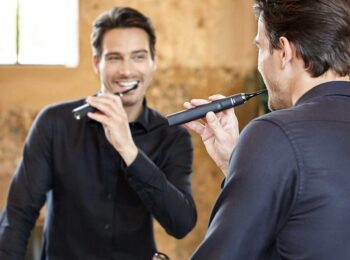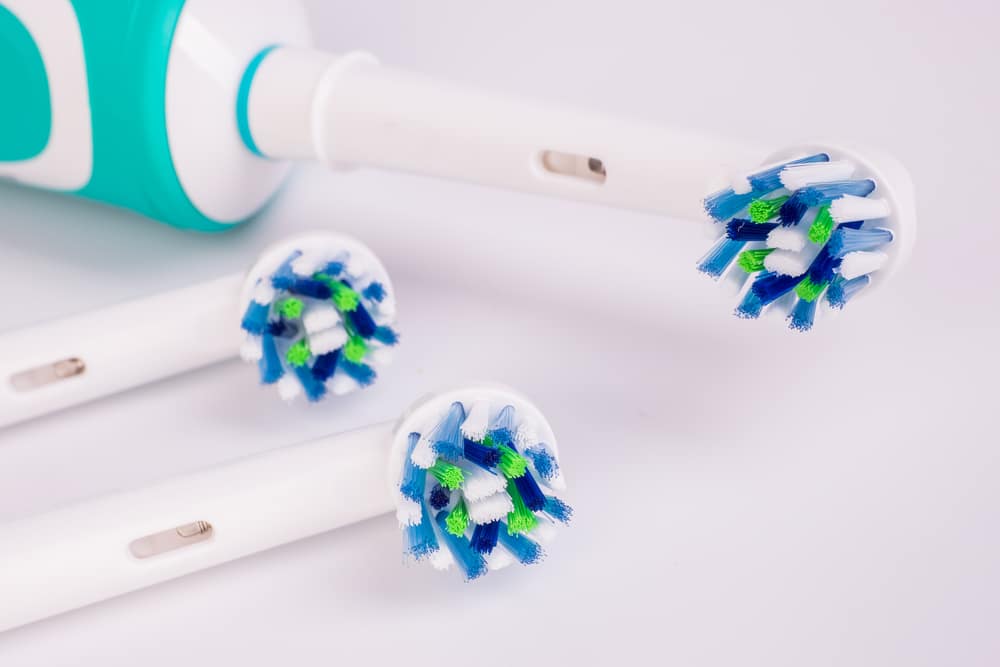An electric toothbrush is a product we all use to clean the insides of our mouths every day. Yet, most of us have no clue how to keep our brush head fresh or when we should change the top on an electric toothbrush.
If you’re keen to upgrade your dental hygiene, learning how to clean an electric toothbrush is a good place to start.
Today, we’re going to cover some of the ways that you can clean the tips of your electric brush. We are also sharing tips on how often to replace your toothbrush heads.
How Often Should You Clean an Electric Toothbrush?
 You probably know that you should replace your manual toothbrush every one or two months – but how often do you clean an electric toothbrush? This depends on a number of things, including the kind of toothbrush head you use and how frequently you rinse your brush after using it.
You probably know that you should replace your manual toothbrush every one or two months – but how often do you clean an electric toothbrush? This depends on a number of things, including the kind of toothbrush head you use and how frequently you rinse your brush after using it.
Cleaning your toothbrush regularly will help prevent unwanted bacteria from re-entering your device the next time you brush your teeth. You may need to clean your toothbrush even more often if you’re unwell.
There’s more to keeping your toothbrush in great condition than just rinsing it off after you’re done cleaning your teeth. The National Dental Association and similar experts agree that you should be cleaning your toothbrush about once per week.
Not thoroughly disinfecting your toothbrush will cause plaque and toothpaste to build up in the brush head and handle.
How Do You Clean Your Electric Toothbrush?
If you have an electric toothbrush from a well-known brand like Oral B, you can always check out the instruction booklet that comes with your device. Many leading brands will give you some advice on toothbrush maintenance and care.
If you don’t have any instructions from your brush head purchases to guide you, you can start with some basic disinfection techniques. For instance, a good option is to remove the head from your electric toothbrushes and soak those toothbrush heads in mouthwash.
View this post on Instagram
Quick Soak
Placing your toothbrush in mouthwash for around 30 minutes should help to remove any of the bacteria it’s collected from your mouth or oral cavity without damaging the bristles. Rinse your toothbrush afterwards to get rid of leftover mouthwash.
Overnight Soak
If you want to clean your toothbrush thoroughly, some dentists suggest leaving your toothbrush in its position within the mouthwash overnight or for several hours. Be sure that the mouthwash you use is strong enough to get rid of harmful microorganisms but not strong enough to damage your bristles.
Other Ways to Clean an Electric Toothbrush
If you don’t think that cleaning your toothbrush with mouthwash is working, and you’re worried that the brush is getting less effective when cleaning, you might want to consider some alternative options.
White Vinegar and Baking Soda
 For instance, some people recommend using distilled white vinegar with baking soda as a great way to thoroughly disinfect a toothbrush.
For instance, some people recommend using distilled white vinegar with baking soda as a great way to thoroughly disinfect a toothbrush.
To use this strategy, you’d need to mix a small amount of water, distilled vinegar, and baking soda in a cup. Next, leave your toothbrush to rest in a head-down position in the mixture overnight. The combination of these household cleaning ingredients should get rid of all unwanted organisms. You can also thoroughly clean the base, and the part where the head is attached with a cotton swab dipped in the cleaning solution.
UV Sanitiser
The great thing about disinfecting your electric toothbrush with a UV sanitiser is you don’t have to expose the brush or your teeth to any dangerous chemicals. You can also place all kinds of toothbrushes under UV light to get rid of germs, from full electric brushes to manual ones.
The lack of moisture means you don’t have to worry about cross-contamination or damaging your handle or battery life either. Just follow the instructions provided on how to use UV light effectively to remove bacteria.
View this post on Instagram
Boiling Water
Placing the bristles and head of your electric toothbrush in very hot water after your brushing routine each day could be a great quick disinfection option. Keep your toothbrush head in the water for at least ten minutes to get rid of bacteria. Do not submerge your full electric toothbrush in the water – just the toothbrush heads. You could damage the handle if you’re not careful.
Hydrogen Peroxide
Some people worry that hydrogen peroxide isn’t the healthiest way to clean electric toothbrushes. However, a mixture of this substance is often ideal for getting rid of germs. Don’t leave your brush head to soak for too long, and remember to rinse it with tap water when you take it out of the mix. Let it air dry before using it again.
Bleach and Water Solutions
It’s important to be cautious if you will be using bleach for disinfecting your toothbrush. You can soak your brush carefully in a mixture of one part bleach to ten parts water to remove unwanted debris.
Electric toothbrush? Soak in a solution of 1part bleach /10 parts water at least once per month. pic.twitter.com/cDrzEudoSE
— Westside Orthodontics (@smileswestside) January 26, 2015
However, compared to bleach, water (even at very high temperatures) and other solutions are safer options. Make sure you rinse the toothbrush with tap water multiple times before using it again. Let it air dry when fully rinsed.
More Tips on How to Clean an Electric Toothbrush
You don’t necessarily need to disinfect and deep clean your toothbrush every day. However, you should be regularly cleaning the toothbrush head and performing maintenance with all the toothbrushes you use.
Showing your toothbrush and brush head proper care will make it last longer. It’s something you can easily do to get the most out of it, particularly if you invested in toothbrushes from Oral B and other leading brands.
Regular toothbrush maintenance can also help you to care for your teeth more effectively by ensuring the brush tips remain stronger for longer. The following toothbrush maintenance tips will keep it in good condition:
Rinse Toothbrush with Water After Every Use
Make sure that you get rid of all toothpaste residue from the bristles. Don’t just leave food debris and toothpaste there to attract mould and bacteria.
Don’t Store Toothbrushes in a Closed Container
Storing your toothbrush in a closed container can create warmth that makes it more conducive for bacterial growth. You should leave your toothbrush to air dry after you’re done rinsing it.
Use Only as Directed
Use your toothbrush as recommended by your dentist and the manufacturer. Don’t place too much pressure on the brush head, and don’t try to power the battery up with too much charge at once. Learn how to use the tool correctly.
Protect the Handle and Battery
Avoid soaking the handle or base of your toothbrush when you’re cleaning it fully. This could affect the unit’s ability to charge over time. Keep your battery in the correct storage containers when you’re travelling.
How Often Should You Replace Your Toothbrush?
With the right care and maintenance, you don’t have to replace your electric toothbrush very often. However, you will need to replace the tips or the toothbrush head regularly. That’s because we apply pressure when we brush our teeth. Thus, the bristles are more likely to wear out quickly.
Cleaning your electric toothbrush will eliminate any leftover dirt and plaque, but it won’t stop the bristles from deteriorating. You can sometimes sign up for messages from toothbrush manufacturers that tell you when it’s time to buy a new head to maintain your healthy smile. Alternatively, you could set up your own reminders based on the time it usually takes for your bristles to wear out.
Replacing your toothbrush head regularly will prevent it from becoming less effective when cleaning your teeth. You can ask your dentist for tips on how often to replace the bristles, but you should have a good idea of the time when your brush doesn’t seem to be working as well anymore.
Replacing the Brush Head
If you notice the bristles are bent and frayed when you’re rinsing your toothbrush with tap water, this is a good sign you need an update. As a general rule, most people will change the heads on their toothbrushes every 2 to 3 months. If you’re using manual toothbrushes, you may need to replace them more regularly.
View this post on Instagram
Replacing Your Electric Toothbrush
If you struggle to get your brush into the right position to remove any leftover debris, or you feel you don’t have the healthiest smile anymore, that could mean you need to replace your toothbrush. Furthermore, if the battery drains quickly or can no longer sufficiently hold a charge, it is due for replacement too.
If you give your full brush the appropriate care and follow the tips mentioned above, you should use the same one for years. Do keep in mind that the handle will eventually show signs of wear too.
Improving Oral Care
Regularly cleaning your electric toothbrush and showing it the right standard of care will ensure it lasts longer. Since a good electric toothbrush can be an expensive investment, it’s worth looking after it properly.
Don’t just rinse your toothbrush each day. Take the time to follow the instructions provided on the manufacturer’s site to learn how to clean an electric toothbrush properly. If you use any chemicals or bleach to remove dirt, thoroughly rinse the brush with tap water, and let it air dry.
Remember that you may need to replace toothbrush heads ahead of time if you’re unwell, you notice the product is wearing out, or if the device is struggling to hold a charge. A battery that won’t charge means you’re basically left with a manual toothbrush.
Let us know your experiences with toothbrushes and how you clean yours.
Additional Resources
Rebekah is a writer who loves to explore new products and find hacks that make life easier. She has a knack for all things home improvement, health and fitness. So you’ll often find her on Pinterest or browsing Houzz for ideas.
She’s always looking for the next thing to fix up around the house or what gadget might be just right for her lifestyle. Rebekah enjoys exploring new recipes, taking care of her family, and making sure she stays healthy with regular workouts at the gym.

